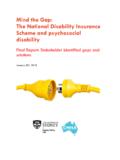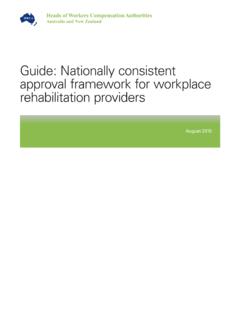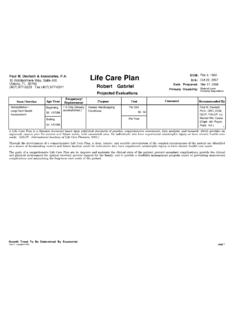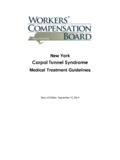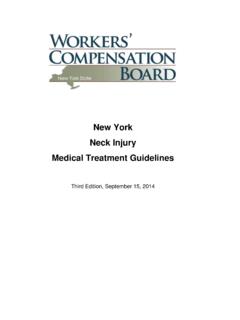Transcription of A Certificate Program in Psychosocial Rehabilitation ...
1 Introduction to Psychosocial Rehabilitation A Certificate Program in Psychosocial Rehabilitation Instructor s Manual CASRA 2002 California Association of Social Rehabilitation Agencies CASRA Introduction to Psychosocial Rehabilitation ii Instructor s Manual Copyright 2002 by California Association of Social Rehabilitation Agencies (CASRA). All rights reserved. No part of this publication may be reproduced in any form without written permission from the publisher. California community college instructors may reproduce materials for classroom use. Published by: California Association for Social Rehabilitation Agencies (CASRA) Phone (925) 229-2300 Fax (925) 229-9088 E-mail Website The courses for the Certificate Program in Psychosocial Rehabilitation are funded by UCSF Center for the Health Professions Allied Health Workforce Innovations for the 21st Century.
2 California Association of Social Rehabilitation Agencies CASRA Introduction to Psychosocial Rehabilitation vii Instructor s Manual Instructor s Manual Introduction to Psychosocial Rehabilitation This course is designed as an overview of the field of Psychosocial Rehabilitation . During the course, the student will review the principles and values of Psychosocial Rehabilitation , emphasizing consumer empowerment and recovery. The course will cover a brief history of the field, current practice models and identify important issues facing the Psychosocial Rehabilitation practitioner today. Learning Objectives 1. Understand the basic principles and values of Psychosocial Rehabilitation . 2. Understand the impact of stigma on people who have a psychiatric disability. 3. Understand the principles of recovery and empowerment in working with people who have a psychiatric disability.
3 4. Understand the importance of bringing cultural sensitivity and awareness to all interactions as a practitioner. 5. Identify a range of practice models utilized in Psychosocial Rehabilitation . 6. Understand the impact of the social movements that have shaped the development and evolution of Psychosocial Rehabilitation services. 7. Demonstrate a basic understanding of ethical practice in Psychosocial Rehabilitation . 8. Understand the basics of formulating a Rehabilitation goal, strengths assessment and documentation. 9. Understand the issues related to transitional youth and strategies for engaging them in their recovery. California Association of Social Rehabilitation Agencies CASRA Introduction to Psychosocial Rehabilitation Welcome and Introduction 1-4 Instructor s Manual Class 1 Handout 2 Syllabus Text Psychiatric Rehabilitation Pratt, Gill, Barrett, and Roberts Class Topics and Readings Class Topic Reading 1 Welcome and Introductions Class Structure Class Agreements Chapter 1 2 Stigma and the Myths of Mental Illness 3 What Is Psychosocial Rehabilitation ?
4 4 Cultural Competence and Worldview Assessment 5 Overview of Diagnosis Chapters 2 & 3 6 Models of Treatment Chapter 4; A New Vision of Recovery by Fisher, 7 Models of Treatment, Continued 8 Rehabilitation Goals Chapter 5 9 Engagement: Finding Strengths 10 Overview of the Mental Health System 11 The Consumer Movement Chapter 6: pp. 139-145 Chapter 9: pp. 234-235 Chapter 10: 12 Working With Families Chapter 11 13 Residential Services Chapters 6 & 9 14 Clubhouse Models and Psychiatric Day Programming 15 Case Management Chapter 8 16 Midterm Exam 17 Intensive Case Management: Working On a Team 18 Laws and Ethics in Psychosocial Rehabilitation 19 Psychiatric Medications 20 Site Visit Reports 21 Self-Help Strategies and Advance Directives 22 Focus on Young People.
5 Transitional Youth Services 23 Supported Education 24 Cultural Issues 25 Dual Diagnosis California Association of Social Rehabilitation Agencies CASRA Introduction to Psychosocial Rehabilitation Welcome and Introduction 1-5 Instructor s Manual Class 1 Class Topic Reading 26 Staying Well on the Job 27 Documentation 28 The Road to Work: Supported Employment Chapter 7 29 Work Incentives and Reasonable Accommodations 30 Consumers As Advocates and Service Providers Chapter 10 31 Rehabilitation Presentations 32 Rehabilitation Presentations California Association of Social Rehabilitation Agencies CASRA Introduction to Psychosocial Rehabilitation Rehabilitation Goals 8-1 Instructor s Manual Class 8 Class 8 Rehabilitation Goals NOTE: You will need the following materials: Poster paper Enough colored markers for each student to have at least three.
6 Discuss the importance of hopes and dreams when creating goals. Where do you see yourself five years from now? Two exercises to identify goals: Exercise 1: Guided visualization about visioning for the future. (20 minutes) Exercise 2: Dream-mapping. (15 minutes) Discussion How did the two exercises work for you? Were you able to visualize? Was drawing easier? Harder? There are many different methods to approaching goals. Each individual learns differently and taps into their creativity using different styles. The Rehabilitation Plan Definition the how to plan to achieve goals what are the skills and resources needed. Overall Rehabilitation goal the larger vision. Consumer choice is central Functional assessment What are the skills and behaviors needed Resource assessment What resources are currently available and identifying what resources are needed.
7 Exercise 3: Functional Assessment and Resource Assessment California Association of Social Rehabilitation Agencies CASRA Introduction to Psychosocial Rehabilitation Rehabilitation Goals 8-2 Instructor s Manual Class 8 Skill Acquisition and Development Go over the following methodologies Skills training and Direct Skills teaching Role-modeling Client-centered approach Behavioral strategies Discuss the principles of skill development (Psych rehab, pg. 127) Homework Assignment Complete the exercise outlined on pg. 131. California Association of Social Rehabilitation Agencies CASRA Introduction to Psychosocial Rehabilitation Rehabilitation Goals 8-3 Instructor s Manual Class 8 Exercise 1 Guided Visualization: Future Plans Ask students to get comfortable in their seats. Ask students to close their eyes, or focus on a spot a few feet ahead, and take three deep breaths.
8 The following is a script for the relaxation and visualization exercise. With each outbreath, allow yourself to relax more fully, letting go of the stresses you have today. Stay with noticing your inbreath and outbreath for the next few minutes. Simply follow your breath as it flows in, and follow the outbreath as you exhale. Do a mini-progressive relaxation exercise. Move through the general body parts from toes to head, tensing and releasing muscle tension. Then you re ready to begin the visualization. You have the day free and it s a beautiful day to go to the beach. You arrive at a quiet beach area. Imagine the sunshine, the blue skies. Feel the gentle breeze and smell the salt air. You have your beach chair or perhaps a blanket, and you begin to walk on the beach, looking for a good spot. The sand is warm on your feet.
9 It feels comforting and supportive on your feet. You find a spot that overlooks the ocean waves you can see the beach for miles in the clear, warm day. In the distance you see a glint of something metal, perhaps, a bright spot that makes you curious. What type of treasure might it be? You leave your chair, or blanket, and begin to walk towards the object. When you reach it, you see that it is a small treasure box, and the object that you saw glinting in the sun is a mirror. The mirror is very ornate, very elaborate and lovely, a treasure in itself. You bring the mirror up to look at your reflection in it. And before you, you see an image of yourself as you have always wanted and hoped to be. The mirror reflects back an image of yourself in the future what characteristics do you see? Are you strong and healthy?
10 Your optimum weight? What is your vocation, your work life like? Relationships? Other things that are important to you are reflected in this wonderful mirror. (Allow the students to stay with this future self for a few minutes, adding details, feeling the positive energy and satisfaction of future goals met) California Association of Social Rehabilitation Agencies CASRA Introduction to Psychosocial Rehabilitation Rehabilitation Goals 8-4 Instructor s Manual Class 8 Make affirmative statements about what you see. I am strong and healthy. I am successful and happy . I am full of energy and creativity. Whatever statements affirm the future self that you see. You begin to notice that the sun is going to set soon. It is time to walk back to your chair or blanket, and begin the trip home. You put the mirror back in the treasure box.
